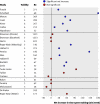Interventions to promote walking: systematic review
- PMID: 17540909
- PMCID: PMC1889976
- DOI: 10.1136/bmj.39198.722720.BE
Interventions to promote walking: systematic review
Abstract
Objective: To assess the effects of interventions to promote walking in individuals and populations.
Design: Systematic review.
Data sources: Published and unpublished reports in any language identified by searching 25 electronic databases, by searching websites, reference lists, and existing systematic reviews, and by contacting experts.
Review methods: Systematic search for and appraisal of controlled before and after studies of the effects of any type of intervention on how much people walk, the distribution of effects on walking between social groups, and any associated effects on overall physical activity, fitness, risk factors for disease, health, and wellbeing.
Results: We included 19 randomised controlled trials and 29 non-randomised controlled studies. Interventions tailored to people's needs, targeted at the most sedentary or at those most motivated to change, and delivered either at the level of the individual (brief advice, supported use of pedometers, telecommunications) or household (individualised marketing) or through groups, can encourage people to walk more, although the sustainability, generalisability, and clinical benefits of many of these approaches are uncertain. Evidence for the effectiveness of interventions applied to workplaces, schools, communities, or areas typically depends on isolated studies or subgroup analysis.
Conclusions: The most successful interventions could increase walking among targeted participants by up to 30-60 minutes a week on average, at least in the short term. From a perspective of improving population health, much of the research currently provides evidence of efficacy rather than effectiveness. Nevertheless, interventions to promote walking could contribute substantially towards increasing the activity levels of the most sedentary.
Conflict of interest statement
Figures



Comment in
-
Physical activity and health.BMJ. 2007 Jun 9;334(7605):1173. doi: 10.1136/bmj.39225.414537.80. BMJ. 2007. PMID: 17556432 Free PMC article.
-
Interventions to promote walking: a review.Clin J Sport Med. 2007 Nov;17(6):516-7. doi: 10.1097/01.jsm.0000299225.75020.b7. Clin J Sport Med. 2007. PMID: 17993803 No abstract available.
References
-
- Chief Medical Officer. At least five a week: evidence on the impact of physical activity and its relationship to health London: Department of Health, 2004
-
- Pate R, Pratt M, Blair S, Haskell W, Macera C, Bouchard C, et al. Physical activity and public health: a recommendation from the Centers for Disease Control and Prevention and the American College of Sports Medicine. JAMA 1995;273:402-7. - PubMed
-
- Sproston K, Primatesta P. Health survey for England 2003 London: Stationery Office, 2004
-
- Bromley C, Sproston K, Shelton N, eds. The Scottish health survey 2003 Edinburgh: Scottish Executive Health Department, 2005
-
- Department of Health. Choosing health: making healthy choices easier London: Stationery Office, 2004
Publication types
MeSH terms
Grants and funding
LinkOut - more resources
Full Text Sources
